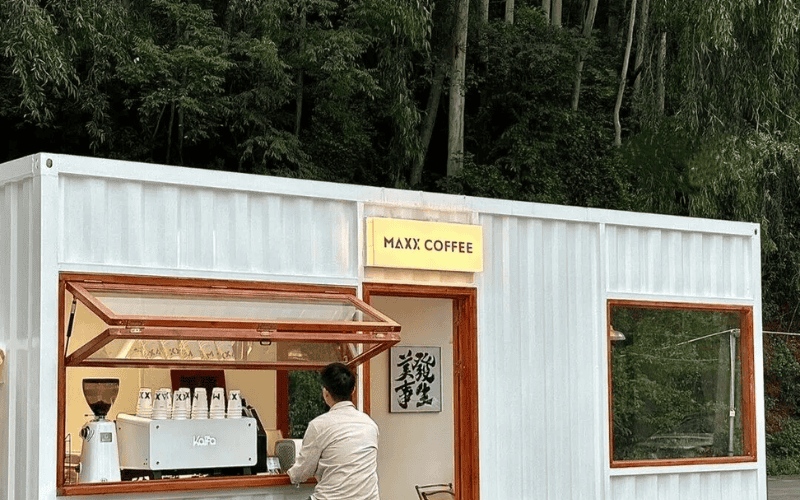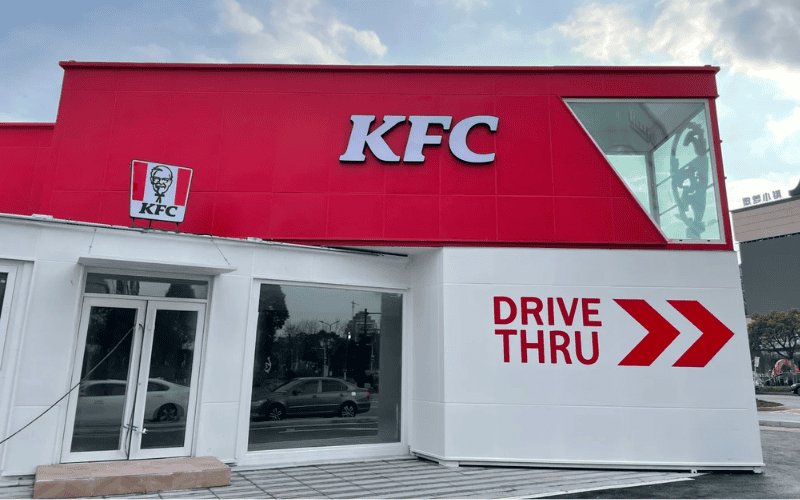Yes! Opening a restaurant is a dream business for many people, but high expenses often make the dream seem out of reach. The construction costs of traditional restaurant buildings may be prohibitive for entrepreneurs.
However, the emergence of prefabricated steel buildings has changed this situation. Not only does it provide a more economical option, but it also has flexibility and efficiency, making it an ideal choice for modern restaurant construction. If you are eager to build a unique and efficient restaurant without breaking the budget, then prefabricated steel buildings are definitely worth considering. Let’s learn about the endless possibilities of prefabricated steel buildings!
Advantages of Prefabricated Steel Buildings in Restaurants
Cost-effectiveness
For restaurants, construction costs are a key consideration. Prefabricated steel buildings offer significant cost advantages, especially when restaurants need to save on initial investment.
Compared with traditional wood or brick buildings, prefabricated steel structures not only have low material costs, but also fast construction speed, reducing additional expenses caused by extended construction periods. Restaurants can build functional and uniquely designed dining spaces at a lower cost.
Fast construction
The opening time of a restaurant is usually closely related to profitability. The fast construction of prefabricated steel buildings can greatly shorten the construction period, allowing restaurants to open as soon as possible.
All components are prefabricated in the factory in advance and only need to be assembled quickly on site. This fast construction method not only effectively saves time, but also avoids construction delays caused by factors such as weather and labor.
Customization
The needs and styles of each restaurant are different, and prefabricated steel buildings can be highly customized according to the specific needs of the restaurant.
Whether it is an open kitchen, lobby layout, private dining area, or exterior style, steel structures can adapt flexibly to help restaurants create a unique and functional dining environment. This personalized design allows restaurants to stand out in the market and meet the different needs of customers.
Durability and safety
Restaurant environments often need to deal with problems such as high temperature, oil smoke, and moisture. Prefabricated steel buildings are highly fire-resistant and corrosion-resistant, and can effectively cope with these challenges.
Steel structures are not easily affected by fire, moisture, or insect pests, ensuring the long-term and stable operation of restaurants. Especially in the kitchen area, steel structures provide additional safety and reduce the risk of fire.
Environmental protection
Green buildings are becoming an increasingly important trend in the catering industry. The steel used in prefabricated steel buildings can be recycled and meet sustainable building standards. The use of steel structures not only reduces the waste of building materials, but also helps restaurants reduce their carbon footprint, enhance their brand image, and attract customers who pay attention to the environment.
Low maintenance costs
Restaurant building maintenance requires long-term investment, while prefabricated steel buildings require almost no additional maintenance work. Steel structures are not troubled by insect pests, rot, cracks, etc., keeping maintenance costs low. Restaurant operators can invest more resources in improving customer experience and food quality instead of worrying about building losses.

Prefabricated steel buildings in restaurants
The restaurant
Modern restaurants, cafes, fast food restaurants, etc. can achieve unique design and functionality through prefabricated steel buildings. Steel structures not only provide large space and flexible layout, but also can match brand positioning through customized appearance design.
Kitchen and storage room
Steel structures provide strong support and can easily carry various heavy kitchen equipment, such as large ovens, refrigeration equipment and kitchen machinery.
The flexibility of steel structures also makes kitchen layout more flexible and can be adjusted according to different operational needs, while also providing ample storage space to help restaurants manage inventory efficiently.
Takeaway and delivery center
The design of steel structures can optimize the distribution process, provide independent pick-up windows, packaging areas and storage space, thereby improving operational efficiency, shortening order processing time, and meeting the growing demand for takeaway.
Cold storage and food processing area
Through the good thermal insulation properties of steel, the restaurant’s cold storage can effectively maintain the required low temperature environment and reduce food waste. At the same time, steel is easy to clean and antibacterial, which can ensure the hygiene and safety of food processing areas and meet strict food safety standards.
Fast Chain Restaurants
Prefabricated steel buildings are an ideal choice for restaurant brands that require high efficiency and multi-location replication. Steel structures can not only be erected quickly, but also customized according to the brand’s needs, ensuring that each branch has a consistent style and functionality.
Specialty and high-end restaurants
Through prefabricated steel buildings, restaurants can create a unique dining environment. For example, some high-end restaurants can use steel frames and glass walls, combined with modern design elements, to create an open and transparent sense of space.
Multifunctional dining space
The flexibility of steel frames allows designers to create different areas such as dining areas, entertainment areas, lounge areas, etc. according to functional requirements, and personalize the design according to the theme of the restaurant.
The scalability and adaptability of steel structures allow restaurants to adjust or expand in the future according to changes in demand, maintaining the long-term competitiveness of the restaurant.
Things to know before deciding to use a prefabricated steel restaurant building
Budget and construction time
Prefabricated steel buildings are generally more cost-effective than traditional buildings, especially in terms of construction period. Understanding the specific cost structure and construction time can help you plan your store opening budget and opening time reasonably and put it into operation as soon as possible.
Regulations and permits
Make sure the selected prefabricated steel building meets local building regulations and food safety standards. Different regions may have different requirements for building materials and catering facilities. Knowing the relevant policies in advance can avoid legal issues later.
Structural and functional requirements
Restaurant design needs to be evaluated based on actual needs, considering space planning, kitchen facilities, storage space, and customer flow. Communicate with the design team to ensure that the prefabricated steel building meets your functional needs without affecting daily operations.
Long-term scalability
The restaurant may need to expand space or change the layout in the future. Prefabricated steel buildings have excellent scalability and can be flexibly adjusted according to needs to support future growth and changes. Therefore, ensuring that expansion space is reserved during design is an important consideration.

7 Design considerations for prefabricated steel structure restaurants
1. Spatial layout and functional requirements
During the design, the spatial requirements of the restaurant must be fully considered to ensure that the layout of the kitchen, storage room, dining area and takeaway/delivery area is reasonable. The open kitchen, the flow of customers in the restaurant and the functional division between different areas must meet the operational needs of the restaurant.
2. Carrying capacity of kitchen facilities
Restaurant kitchens need to install heavy equipment (such as stoves, ovens, refrigerators, etc.), so the steel structure design must have sufficient load-bearing capacity. In addition, the stability of steel can ensure the safety of equipment under long-term use.
3. Ventilation and air conditioning system
The air circulation in the restaurant, especially in the kitchen area, is very important. When designing, the layout of the ventilation system needs to be considered to ensure smooth air circulation, rapid discharge of oil smoke and moisture, and effective regulation of temperature and humidity.
4. Fire prevention and safety
Steel structure itself has the advantage of fire prevention, but the restaurant kitchen is a high-temperature environment. Special attention should be paid to fire safety during design, including fire partitions, automatic fire extinguishing systems and smoke exhaust design to ensure the safety of employees and customers.
5. Lighting and energy efficiency
The use of natural light in restaurants needs to be considered in the design. Designs such as large windows and transparent roofs can increase the entry of natural light, reduce energy consumption, and improve the environmental comfort and energy saving effect of the restaurant.
6. Hygiene and cleaning
The restaurant is a place with extremely high hygiene requirements. The surface of the steel structure is flat and smooth and easy to clean. When designing, the materials of the floor, wall and equipment should be considered to ensure that the cleaning work is simple and meets food safety standards.
7. External environment and climate factors
Depending on the climate of the area where the restaurant is located, the steel structure design must ensure that it can adapt to different climatic conditions, such as wind resistance, earthquake resistance, moisture resistance and other functions, especially durability against extreme weather and external environment.
Our prefabricated steel restaurant building product configurations
Structural options
We offer a variety of roof, wall, door and window system configurations to meet the various functional needs of restaurants.
For example, the roof can be a pitched roof, a flat roof or other customized designs, and the wall can be made of weathering steel plates, glass curtain walls or other materials that suit the brand image. The door and window system can also be customized according to the layout requirements of the restaurant to provide better security, lighting and ventilation effects.
Customization options
We offer a variety of customization options to meet the unique needs of restaurant brands. You can choose wall colors, door and window styles, internal partitions, and decoration designs according to the brand style to ensure that the restaurant’s appearance and interior layout match the brand image and enhance the visual appeal of the restaurant.
Technical configuration
In order to improve the efficiency of steel restaurant operations, we provide a series of technical configurations, such as air conditioning systems, ventilation systems, lighting designs, etc. These technical solutions can help restaurants achieve energy-saving goals, improve the comfort of employees’ working environment, and ensure food safety and hygiene.
FAQ
Will the steel structure affect the aesthetics of the restaurant?
No. Through design customization, the steel structure can be combined with modern and fashionable elements to meet the aesthetic needs of the restaurant.
How is the sound insulation effect of the steel structure restaurant?
The steel structure restaurant can ensure the internal noise control of the restaurant and create a comfortable dining environment through reasonable design and sound insulation materials.
Can I customize the appearance of the restaurant according to brand requirements?
Yes. The steel structure restaurant can be customized in many aspects such as color, appearance, doors and windows to perfectly match your brand image.
Can the prefabricated steel structure meet local regulations and building requirements?
We ensure that all designs and constructions comply with local building regulations and food safety standards to ensure smooth approval.

